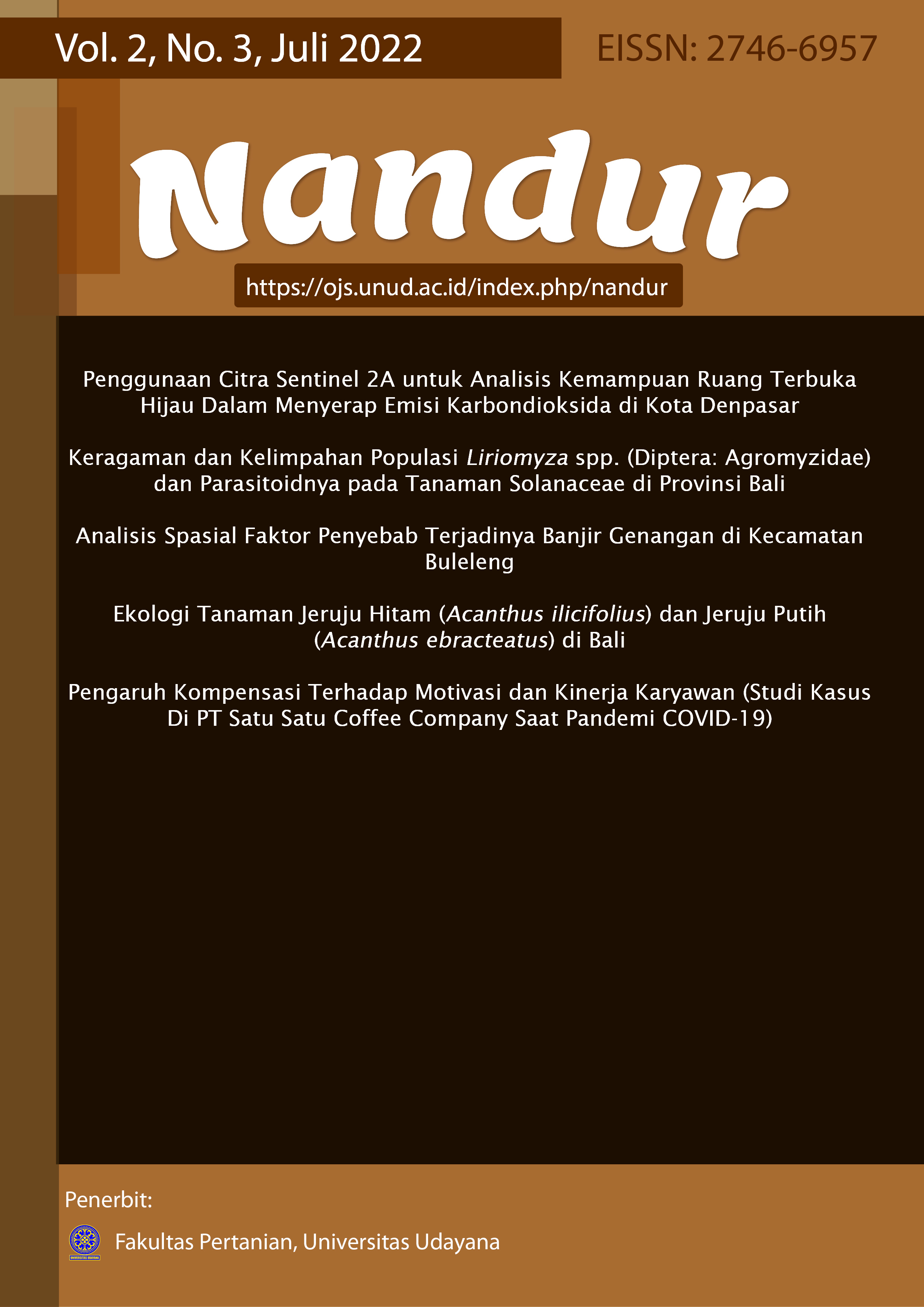Analisis Spasial Faktor Penyebab Terjadinya Banjir Genangan di Kecamatan Buleleng
Abstract
Buleleng Subdistrict is one of the sub-districts in Buleleng Regency that has experienced land use changes that have resulted in reduced water catchment areas, so they are vulnerable to flooding. Therefore, it is necessary to study floods in the Buleleng District. The study aimed to determine the distribution of potential flood areas and analyze the potential for flooding in the space utilization area in Buleleng District. This research was carried out in Kecataman Buleleng from September to December 2021. The scoring method refers to the Bali Provincial Bappeda and PPLH Unud (2006) and overlays from rainfall maps, land use, slope slopes, place height, river distance, and soil type. Factors causing flooding in Buleleng District include flat to gentle slopes, altitude 0-50 m above sea level, distance from river 0-5 m, and relatively high rainfall. The land use of the Buleleng sub-district is dominated by a residential area of 1,892.27 ha (40.90%). The average rainfall that dominates the research area is 1,500-2,000 mm/year, with the moderately wet category occurring almost evenly in the study area of 3,722.56 ha (80.46%). The distribution of sloping slopes (>8-15%) dominates the research area, which is spread over an area of 2,633.04 ha (56.91%) with a land height ranging from 10-50 m to an area of 1,692.62 ha (36.58%). The distance of the river that will provide inundation of river water dominates the research area with a very high category at a distance of 0-50 m 1,160.64 ha (25.09%). Based on the study results, countermeasures can be suggested for areas with the characteristics of potential flooding based on the spatial data of this study. Such as repairing drainage channels before the rainy season, making biopore, and increasing green area space by planting reforestation plants on vacant land to improve soil structure need government attention and public awareness.
References
Diara, I. W., Suyarto, R., & Saifulloh, M. (2022). Spatial Distribution of Landslide Susceptibility In New Road Construction Mengwitani-Singaraja, Bali-Indonesia: Based On Geospatial Data. GEOMATE Journal, 23(96), 95–103. https://doi.org/https://doi.org/10.21660/2022.96.3320
Heryani, R., Paharuddin, Arif, S. (2013). Analisis Kerawanan Banjir Berbasis Spasial Menggunakan Analytical Hierarchy Process (AHP) Kabupaten Maros. Makassar: Universitas Hasanuddin.
Pratomo, A.J. (2008). Analisis Kerentanan Banjir di Daerah Aliran Sungai Sengkarang Kabupaten Pekalongan Provinsi Jawa Tengah dengan Bantuan Sistem Informasi Geografis. Surakarta: Fakultas Geografi. Universitas Muhammadiyah Surakarta.
Saifulloh, M., Sardiana, I. K., & Supadma, A. (2017). Pemetaan Kualitas Tanah pada Lahan Kebun Campuran dengan Geography Information System (GIS) di Kecamatan Tegallalang, Kabupaten Gianyar. E-Jurnal Agroekoteknologi Tropika, 6(3), 269-278.
Sardiana, I. K., Susila, D., Supadma, A. A., & Saifulloh, M. (2017). Soil Fertility Evaluation and Land Management of Dryland Farming at Tegallalang Sub-District, Gianyar Regency, Bali, Indonesia. In IOP Conference Series: Earth and Environmental Science (Vol. 98, No. 1, p. 012043). IOP Publishing.
Suharta, K., Merit, N. dan Sunarta, N. (2008). Studi Peresapan Air Hujan di Kota Denpasar. Journal Ecotropic 3 (2): 49 - 54.
Sunarta, I. N., & Saifulloh, M. (2022). Spatial Variation Of NO2 Levels During The Covid-19 Pandemic In The Bali Tourism Area. Geographia Technica, Vol. 17, Issue 1, 2022, pp 141 to 150. https://doi.org/10.21163/GT_2022.171.11
Sunarta, I. N., & Saifulloh, M. (2022). Coastal Tourism: Impact For Built-Up Area Growth And Correlation to Vegetation and Water Indices Derived from Sentinel-2 Remote Sensing Imagery. GeoJournal of Tourism and Geosites, 41(2), 509-516. https://doi.org/10.30892/gtg.41223-857
Trigunasih, N.M., & Saifulloh. M. (2022). Spatial Distribution of Landslide Potential and Soil Fertility: A Case Study in Baturiti District, Tabanan, Bali, Indonesia. Journal of Hunan University Natural Sciences, 49(2).



